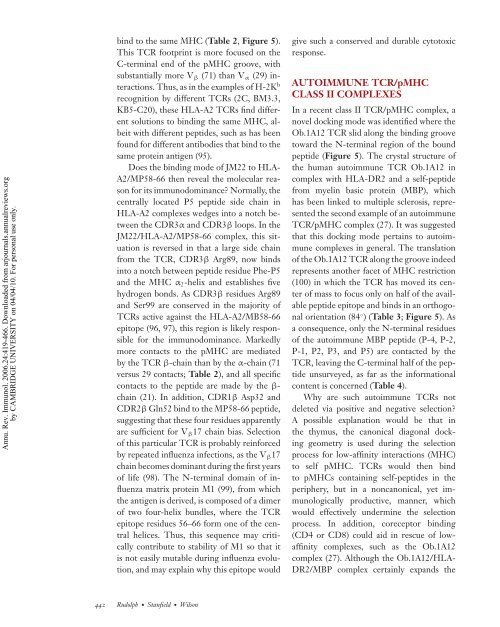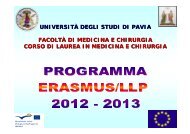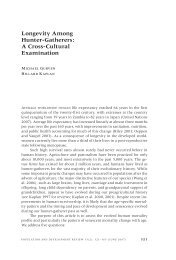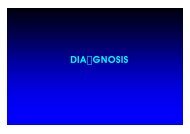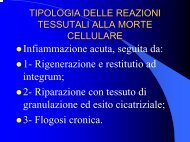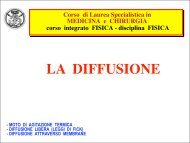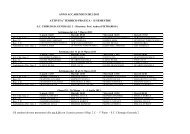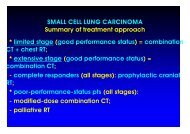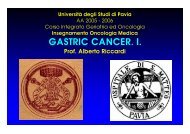Rudolph MG
Rudolph MG
Rudolph MG
You also want an ePaper? Increase the reach of your titles
YUMPU automatically turns print PDFs into web optimized ePapers that Google loves.
Annu. Rev. Immunol. 2006.24:419-466. Downloaded from arjournals.annualreviews.org<br />
by CAMBRIDGE UNIVERSITY on 04/04/10. For personal use only.<br />
bind to the same MHC (Table 2, Figure 5).<br />
This TCR footprint is more focused on the<br />
C-terminal end of the pMHC groove, with<br />
substantially more Vβ (71) than Vα (29) interactions.<br />
Thus, as in the examples of H-2K b<br />
recognition by different TCRs (2C, BM3.3,<br />
KB5-C20), these HLA-A2 TCRs find different<br />
solutions to binding the same MHC, albeit<br />
with different peptides, such as has been<br />
found for different antibodies that bind to the<br />
same protein antigen (95).<br />
Does the binding mode of JM22 to HLA-<br />
A2/MP58-66 then reveal the molecular reason<br />
for its immunodominance? Normally, the<br />
centrally located P5 peptide side chain in<br />
HLA-A2 complexes wedges into a notch between<br />
the CDR3α and CDR3β loops. In the<br />
JM22/HLA-A2/MP58-66 complex, this situation<br />
is reversed in that a large side chain<br />
from the TCR, CDR3β Arg89, now binds<br />
into a notch between peptide residue Phe-P5<br />
and the MHC α2-helix and establishes five<br />
hydrogen bonds. As CDR3β residues Arg89<br />
and Ser99 are conserved in the majority of<br />
TCRs active against the HLA-A2/MB58-66<br />
epitope (96, 97), this region is likely responsible<br />
for the immunodominance. Markedly<br />
more contacts to the pMHC are mediated<br />
by the TCR β-chain than by the α-chain (71<br />
versus 29 contacts; Table 2), and all specific<br />
contacts to the peptide are made by the βchain<br />
(21). In addition, CDR1β Asp32 and<br />
CDR2β Gln52 bind to the MP58-66 peptide,<br />
suggesting that these four residues apparently<br />
are sufficient for Vβ17 chain bias. Selection<br />
of this particular TCR is probably reinforced<br />
by repeated influenza infections, as the Vβ17<br />
chain becomes dominant during the first years<br />
of life (98). The N-terminal domain of influenza<br />
matrix protein M1 (99), from which<br />
the antigen is derived, is composed of a dimer<br />
of two four-helix bundles, where the TCR<br />
epitope residues 56–66 form one of the central<br />
helices. Thus, this sequence may critically<br />
contribute to stability of M1 so that it<br />
is not easily mutable during influenza evolution,<br />
and may explain why this epitope would<br />
442 <strong>Rudolph</strong>· Stanfield· Wilson<br />
give such a conserved and durable cytotoxic<br />
response.<br />
AUTOIMMUNE TCR/pMHC<br />
CLASS II COMPLEXES<br />
In a recent class II TCR/pMHC complex, a<br />
novel docking mode was identified where the<br />
Ob.1A12 TCR slid along the binding groove<br />
toward the N-terminal region of the bound<br />
peptide (Figure 5). The crystal structure of<br />
the human autoimmune TCR Ob.1A12 in<br />
complex with HLA-DR2 and a self-peptide<br />
from myelin basic protein (MBP), which<br />
has been linked to multiple sclerosis, represented<br />
the second example of an autoimmune<br />
TCR/pMHC complex (27). It was suggested<br />
that this docking mode pertains to autoimmune<br />
complexes in general. The translation<br />
of the Ob.1A12 TCR along the groove indeed<br />
represents another facet of MHC restriction<br />
(100) in which the TCR has moved its center<br />
of mass to focus only on half of the available<br />
peptide epitope and binds in an orthogonal<br />
orientation (84 ◦ )(Table 3; Figure 5). As<br />
a consequence, only the N-terminal residues<br />
of the autoimmune MBP peptide (P-4, P-2,<br />
P-1, P2, P3, and P5) are contacted by the<br />
TCR, leaving the C-terminal half of the peptide<br />
unsurveyed, as far as the informational<br />
content is concerned (Table 4).<br />
Why are such autoimmune TCRs not<br />
deleted via positive and negative selection?<br />
A possible explanation would be that in<br />
the thymus, the canonical diagonal docking<br />
geometry is used during the selection<br />
process for low-affinity interactions (MHC)<br />
to self pMHC. TCRs would then bind<br />
to pMHCs containing self-peptides in the<br />
periphery, but in a noncanonical, yet immunologically<br />
productive, manner, which<br />
would effectively undermine the selection<br />
process. In addition, coreceptor binding<br />
(CD4 or CD8) could aid in rescue of lowaffinity<br />
complexes, such as the Ob.1A12<br />
complex (27). Although the Ob.1A12/HLA-<br />
DR2/MBP complex certainly expands the


